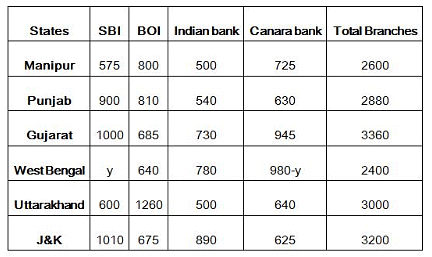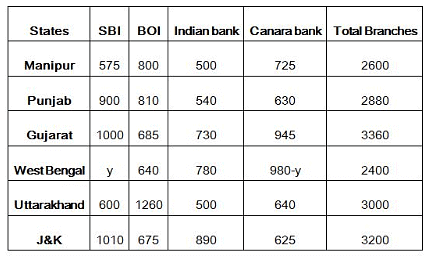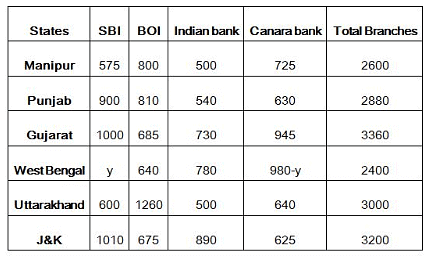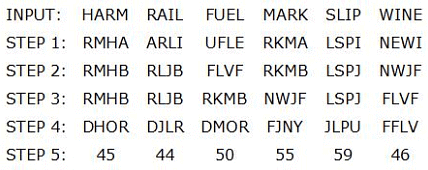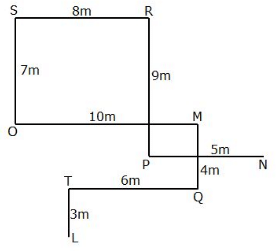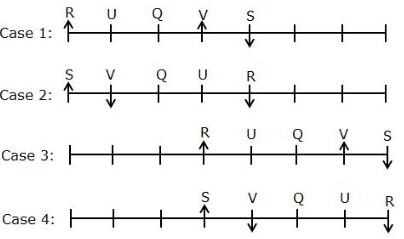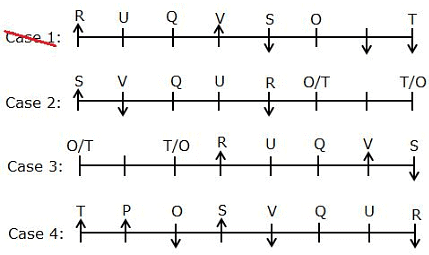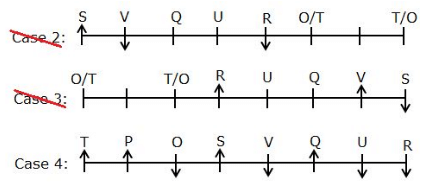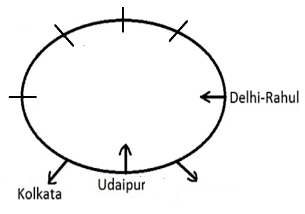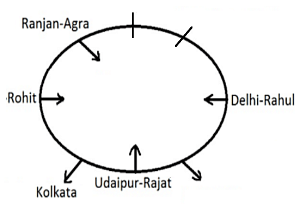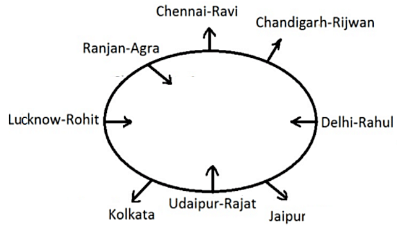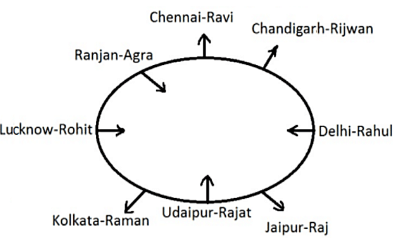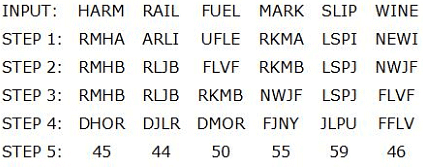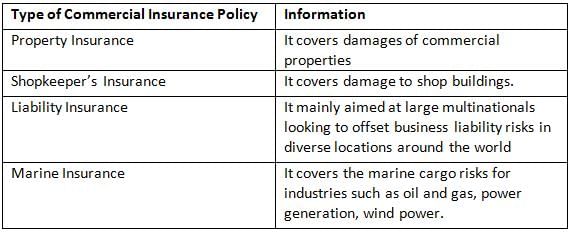PFRDA Assistant Manager Phase 1 Mock Test - 10 (Paper 1) - Insurance Exams MCQ
30 Questions MCQ Test PFRDA Assistant Manager Mock Test Series 2025 - PFRDA Assistant Manager Phase 1 Mock Test - 10 (Paper 1)
Direction: Read the following passage carefully and answer the question that follows.
The Supreme Court on Tuesday asked the Union government whether it is giving the over 40 lakh people, excluded from the National Register of Citizens (NRC) in Assam, a “second chance” to gain citizenship by allowing them to produce fresh documents to prove their Indian legacy.
The court was referring to the Standard Operating Procedure (SOP) proposed by the government, which allows a claimant for Indian citizenship to “change his legacy” by submitting additional documents at the ‘claims and objections’ stage. The court asked whether this would amount to “re-doing the claims” of those left out from the draft NRC published on July 30.
A Bench of Justices Ranjan Gogoi and Rohinton Nariman on Tuesday said allowing a claimant to change his legacy would amount to “tinkering with the family tree” and re-doing the verification process.
“You see, a claimant submits documents to prove his legacy from his father. A family tree is drawn, which includes the claimant’s siblings, etc. The authorities verify his claim with each one of the member in the family tree before deciding his claim [for citizenship]. Now, your SOP says that a person can submit fresh documents claiming to prove his legacy from his grandfather. Now, the family tree has to be recreated. Everything has to be re-verified. This amounts to redoing the entire exercise. Why?”, Justice Gogoi asked Attorney General K.K. Venugopal.
Besides, the Bench pointed out, the government, in the beginning, had specified that documents on legacy would be allowed to be filed only once. Now, it has changed tack to permit additional documents to be filed. “Are you not contradicting yourself here?” Justice Gogoi asked Mr. Venugopal.
The court directed Assam State NRC Coordinator Prateek Hajela to file a report on the ramifications of the government's proposal to submit fresh documents. Mr. Hajela has to file his report before September 5, the next date of hearing.
Meanwhile, the court deferred the receipt of claims and objections to a later date. This stage was supposed to start within the next days, on August 30, and would have continued till October 28.
“Allowing a person to suddenly pull out an additional document, that too at the 'claims and objections' stage, will upset the search apple cart,” Justice Nariman observed.
Mr. Venugopal countered that the government is giving “another chance to people who risk losing all their rights”.
To this, Justice Nariman agreed that the court was dealing with “human problems of a huge magnitude”.
“Consequences are so severe that should they be given one more chance. Suppose a claimant has misfired once but can deliver in the next. Why should such a person not be given another chance?” Justice Nariman asked Mr. Hajela, stakeholders and petitioners in the litigation.
To this, Mr. Hajela said reopening of family trees would risk the possibility of “trading of legacies or meeting of minds”. "Giving a second chance would only open trading in legacies. There may be people who are willing to sell the legacies to others,” he said.
The Supreme Court further asked Mr. Hajela to submit a report with a time-frame to carry out the sample re-verification of at least 10 per cent of the names included in the final draft NRC. This is after Mr. Hajela placed before the Bench a district-wise data of the percentage of the population who have been excluded from the final draft NRC.
Q. Which among the following is a possible consequence of the new standard operating procedure adopted by the Government regarding the National Register of Citizens?
Direction: Read the following passage carefully and answer the question that follows.
The Supreme Court on Tuesday asked the Union government whether it is giving the over 40 lakh people, excluded from the National Register of Citizens (NRC) in Assam, a “second chance” to gain citizenship by allowing them to produce fresh documents to prove their Indian legacy.
The court was referring to the Standard Operating Procedure (SOP) proposed by the government, which allows a claimant for Indian citizenship to “change his legacy” by submitting additional documents at the ‘claims and objections’ stage. The court asked whether this would amount to “re-doing the claims” of those left out from the draft NRC published on July 30.
A Bench of Justices Ranjan Gogoi and Rohinton Nariman on Tuesday said allowing a claimant to change his legacy would amount to “tinkering with the family tree” and re-doing the verification process.
“You see, a claimant submits documents to prove his legacy from his father. A family tree is drawn, which includes the claimant’s siblings, etc. The authorities verify his claim with each one of the member in the family tree before deciding his claim [for citizenship]. Now, your SOP says that a person can submit fresh documents claiming to prove his legacy from his grandfather. Now, the family tree has to be recreated. Everything has to be re-verified. This amounts to redoing the entire exercise. Why?”, Justice Gogoi asked Attorney General K.K. Venugopal.
Besides, the Bench pointed out, the government, in the beginning, had specified that documents on legacy would be allowed to be filed only once. Now, it has changed tack to permit additional documents to be filed. “Are you not contradicting yourself here?” Justice Gogoi asked Mr. Venugopal.
The court directed Assam State NRC Coordinator Prateek Hajela to file a report on the ramifications of the government's proposal to submit fresh documents. Mr. Hajela has to file his report before September 5, the next date of hearing.
Meanwhile, the court deferred the receipt of claims and objections to a later date. This stage was supposed to start within the next days, on August 30, and would have continued till October 28.
“Allowing a person to suddenly pull out an additional document, that too at the 'claims and objections' stage, will upset the search apple cart,” Justice Nariman observed.
Mr. Venugopal countered that the government is giving “another chance to people who risk losing all their rights”.
To this, Justice Nariman agreed that the court was dealing with “human problems of a huge magnitude”.
“Consequences are so severe that should they be given one more chance. Suppose a claimant has misfired once but can deliver in the next. Why should such a person not be given another chance?” Justice Nariman asked Mr. Hajela, stakeholders and petitioners in the litigation.
To this, Mr. Hajela said reopening of family trees would risk the possibility of “trading of legacies or meeting of minds”. "Giving a second chance would only open trading in legacies. There may be people who are willing to sell the legacies to others,” he said.
The Supreme Court further asked Mr. Hajela to submit a report with a time-frame to carry out the sample re-verification of at least 10 per cent of the names included in the final draft NRC. This is after Mr. Hajela placed before the Bench a district-wise data of the percentage of the population who have been excluded from the final draft NRC.
Q. Which among the following is true regarding the view of the Supreme Court regarding the Standard Operating Procedure announced by the government?
Direction: In the questions given below a sentence is given with two blanks in each. Corresponding to each question two columns are given with three words in each column. Which combination of words from the two columns will perfectly fit into the blanks to make the sentence contextually correct and meaningful?
The protests in Guwahati were the most intense so far and some of the infrastructure being built for the ____________ between PM Abe and PM Modi were ____________ and burnt by the protesters.
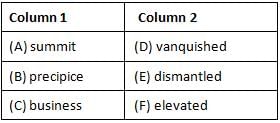

Direction: Each question below has one blank, which is indicating that something has been omitted. Find out which option can be used to fill up the blank in the sentence in the same sequence to make it meaningfully complete.
The tax department has been stepping up its _____________ of your financial activities and it has also been making compliance easy.
Directions: In the following passage, some of the words have been left out, each of which is indicated by a letter. Find the suitable word from the options given against each letter and fill up the blanks with appropriate words to make the paragraph meaningful.
The chess world was _____(A)_____ in late 2022 when Magnus Carlsen, the current world champion, accused Hans Niemann, a 19-year-old US chess grandmaster, of cheating using a chess-playing artificial intelligence (AI) system. Niemann had defeated Carlsen, prompting Carlsen’s _____(B)_____; Niemann asserted that he had played Carlsen fairly even though he later admitted to having cheated twice in online chess games, at the ages of 12 and 16.
A month later, a 72-page investigation report drafted by Chess.com _____(C)_____ that Niemann had “likely cheated” more than a hundred times while playing online chess. But the report also said, “There is no direct _____(D)_____ that proves Hans cheated at the September 4, 2022, game with Magnus.”
Cheating in chess has become a major problem, especially in the online era. Among the more-than 500,000 accounts that Chess.com has _____(E)_____ for cheating, more than 500 belonged to titled players (titling is a mark of skill). By the beginning of 2024, the site expects to close more than a million accounts.
Q. Select the most appropriate option that will fill in the blank (B).
Directions: In the following passage, some of the words have been left out, each of which is indicated by a letter. Find the suitable word from the options given against each letter and fill up the blanks with appropriate words to make the paragraph meaningful.
The chess world was _____(A)_____ in late 2022 when Magnus Carlsen, the current world champion, accused Hans Niemann, a 19-year-old US chess grandmaster, of cheating using a chess-playing artificial intelligence (AI) system. Niemann had defeated Carlsen, prompting Carlsen’s _____(B)_____; Niemann asserted that he had played Carlsen fairly even though he later admitted to having cheated twice in online chess games, at the ages of 12 and 16.
A month later, a 72-page investigation report drafted by Chess.com _____(C)_____ that Niemann had “likely cheated” more than a hundred times while playing online chess. But the report also said, “There is no direct _____(D)_____ that proves Hans cheated at the September 4, 2022, game with Magnus.”
Cheating in chess has become a major problem, especially in the online era. Among the more-than 500,000 accounts that Chess.com has _____(E)_____ for cheating, more than 500 belonged to titled players (titling is a mark of skill). By the beginning of 2024, the site expects to close more than a million accounts.
Q. Select the most appropriate option that will fill in the blank (D).
Directions: Rearrange the following five sentences A, B, C, D and E in the proper sequence to form a meaningful paragraph and then answer the question given beside.
A. Such was the respect she garnered for her medal-winning exploits at the Asian level.
B. Additionally, it busts the patriarchy inherent in many sports hierarchies across India.
C. After she retired from track-and-field, she evolved as a coach, groomed fresh talent and kept an eye on the grassroots.
D. Decades ago, when P.T. Usha travelled by the Madras-Mangalore Mail, her employers, the Railways, permitted an unscheduled stop at her hometown Payyoli in North Kerala.
E. Her latest appointment as president of the Indian Olympic Association (IOA) comes with a surfeit of goodwill.
Which of the following will be the FIRST statement after the rearrangement of sentences?
I have / two sister-in-laws / whose husbands / are all well settled.
Read the following information carefully and answer the following questions
The following table shows the number of branches of different banks in various states
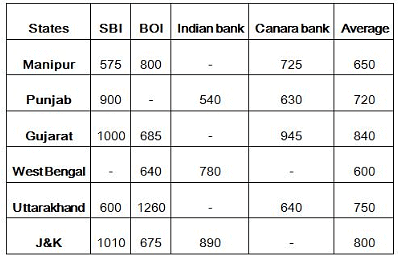
Total branches in the particular states = sum of the branches of all the bank’s branches in that state.
If the number of branches of SBI in West Bengal is 580, then find the difference between no. of branches in SBI and Canara bank from West Bengal.
Directions: Study the following information to answer the given question.
Number of students who appeared in SSC examination from five schools over the year
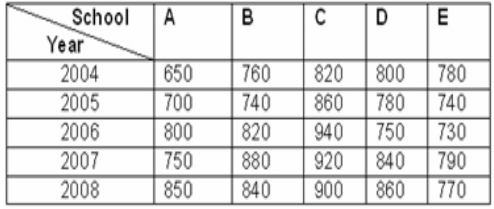
What is the ratio of the total number of students who appeared in 2004 and 2005 together from school C to that of those who appeared from school D?
What approximate values come in place of (?) in the following questions? You are not expected to calculate the exact value.
236.60 + 247.90 - (?)² = - (31.87% of 599)
Directions: The question below is followed by three statements labelled I, II and III. You have to consider the information in all the three statements and decide which of the statements is/are necessary to answer the question. Indicate your answer accordingly.
What is the monthly income of Mr. X?
I. Mr. X spends 85% of his monthly income on various items and the remaining amount is saved.
II. Monthly savings of Mr. X are Rs. 4500.
III. Out of the total money spent by Mr. X in a month, one-fifth is spent on food and the remaining amount of Rs. 20,400 on other items.
Read the following information carefully and answer the following questions
The following table shows the number of branches of different banks in various states
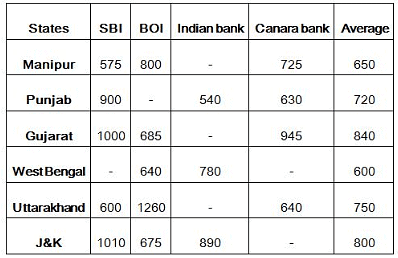
Total branches in the particular states = sum of the branches of all the bank’s branches in that state.
Find the ratio of number of branches in BOI from Punjab to the number of branches in canara bank from J&K.
Directions: Study the following information to answer the given question.
Number of students who appeared in SSC examination from five schools over the year
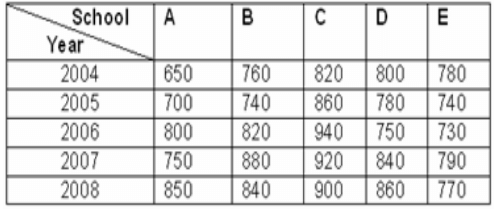
Number of students that appeared in 2006 from school A is what percentage of the total number of students that appeared from school A for all the years together?
Read the following information carefully and answer the following questions
The following table shows the number of branches of different banks in various states
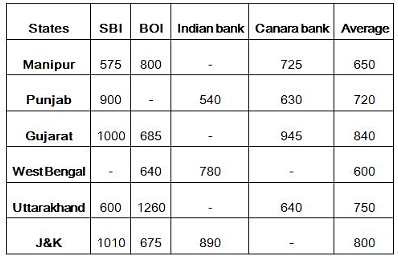
Total branches in the particular states = sum of the branches of all the bank’s branches in that state.
Find the average (approx.) number of branches in BOI from all the states together.
Study the following information carefully and answer the below questions:
A word arrangement machine when given an input rearranges them by following a particular rule in each step. The following is an illustration of input and steps rearrangement.
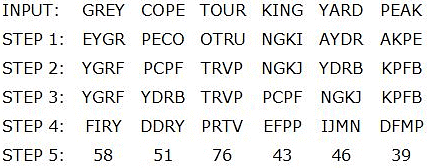
STEP 5 is the last and final step of the rearrangement. As per the rules followed in the above steps, find out in each of the following questions the appropriate step for the following input.
![]()
What will be the difference between the numbers which are second from the right end and third from the left end in the final step of the given input?
Study the following information carefully and answer the below questions:
In one fine morning, a person stands in the ground at point L such that the shadow of the person falls to his left. He walks for 3m straight to reach point T and turns to his right to walk for 6m to reach point Q. He then walks 4m to reach point M after taking a left turn. At point M, he takes a left turn to walk for 10m to reach point O from where he takes a right turn and walks 7m to reach point S. He then walks 8m to reach point R after taking a right turn and then walks 9m towards his right to reach point P. Finally he takes a left turn and walks for 5m to reach point N and stops.
In which of the following direction does the person starts the journey?
Study the following information carefully and answer the below questions:
Eight persons viz. O, P, Q, R, S, T, U and V are standing on a straight line such that some of them are facing north while some are facing south, but not necessarily in the same order. Not more than two adjacent persons face the same direction.
Q stands third from one of the ends and immediately adjacent to both U and V.S stands to the immediate right of V but faces opposite direction to V and four persons away from R who faces the same direction as V.Only one person stands between O and T who doesn’t sit adjacent to S but faces the same direction as S. The immediate neighbours of O face the same direction but O doesn’t face north. The number of persons to the left of both P and U are the same.
How many persons stand between O and R?
If all the letters in the word “GENTRIFICATION” are arranged in alphabetical order from left to right, then how many letters remain unchanged in their position?
Directions: Study the following information to answer the question.
Eight persons Rahul, Ravi, Ranjan, Raman, Rijwan, Rohit, Rajat and Raj are sitting around a circle. Some of them are facing the centre of the circle and the rest are facing outside. These persons belong to various cities viz. Chennai, Chandigarh, Jaipur, Udaipur, Kolkata, Lucknow, Delhi and Agra, but not necessarily in the same order.
Rahul is facing the centre and belongs to Delhi. Both the persons who belong to Chennai and Udaipur are not the immediate neighbours of Rahul. The person who belongs to Udaipur is the immediate neighbour of both the persons who are facing outside. Ranjan is facing the centre and sitting third to the left of Rajat. The person who is from Udaipur is facing the centre. The person who is from Kolkata is facing outside the circle and is an immediate neighbour of Rohit. Ravi is facing outside the circle and is the immediate neighbour of both Ranjan and Rijwan. The person who belongs to Chennai is facing outside and is an immediate neighbour of the person who is from Chandigarh. The person who is from Jaipur is facing outside and is second to the right of Rijwan. The person who is from Udaipur is sitting second to the left of Rahul. The person who is from Kolkata is sitting to the immediate left of the person who is from Udaipur. Ravi is from neither Kolkata nor Jaipur. None of the immediate neighbours of the persons who are from Kolkata and Jaipur is facing outside. Ranjan belongs to Agra and is an immediate neighbour of Rohit. Raman does not belong to Jaipur.
Find out the correct combination.
Directions: Following question is followed by statements I and II. Answer the question using the following instructions.
Choose (A) if the question can be answered by using statement I alone, but not by using II alone.
Choose (B) if the question can be answered by using statement II alone, but not by using I alone.
Choose (C) if the question can be answered by using either statement alone.
Choose (D) if the question can be answered by using both the statements together, but not by using any of the statements alone.
Choose (E) if the question cannot be answered by using both the statements together.
Out of three boys and two girls, a team of three needs to be formed. How many boys are there in the team?
I. For every girl, there must be two boys in the team.
II. The team must include at least one girl.
Study the following information carefully and answer the below questions:
A word arrangement machine when given an input rearranges them by following a particular rule in each step. The following is an illustration of input and steps rearrangement.
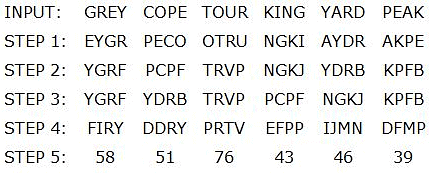
STEP 5 is the last and final step of the rearrangement. As per the rules followed in the above steps, find out in each of the following questions the appropriate step for the following input.
![]()
How many letters are there between the third letter of the second word from the left end and the second letter of the second word from the right end in step 4 according to the English alphabetical series?
Consider the following statements regarding the lac insect and its role in pigment production:
1. The lac insect completes its life cycle through a hemimetabolous process including egg, nymph instars, pupa, and adult stages.
2. Laccaic acid, produced by the lac insect, requires an amino acid called tyrosine, which the insect obtains directly from the tree sap.
3. Kusumi and rangeeni are two prominent strains of lac insects found in India, and both are capable of producing commercial lac.
Which of the statements given above is/are correct?
Consider the following statements regarding the Money and Capital market in India:
- Money markets are generally much safer than capital markets.
- Investment in the capital market requires a huge financial outlay to invest compared to the money market.
- Capital market generally yields a higher return for investors than the money markets.
Which of the statements given above is/are correct?
Which among the following is NOT a correct statement?
When was the Bombay stock exchange set-up?
What is the minimum paid-up capital a bank must have to be eligible for inclusion in the Reserve Bank of India Act, 1934's Second Schedule to attain Scheduled Banks’ status?
Which of the following Company is the first to install a White Label ATM in India?
Which among the following is the tenure of the Treasury Bills issued by the Government of India?
Which of the following is type of Commercial Insurance Policy?



